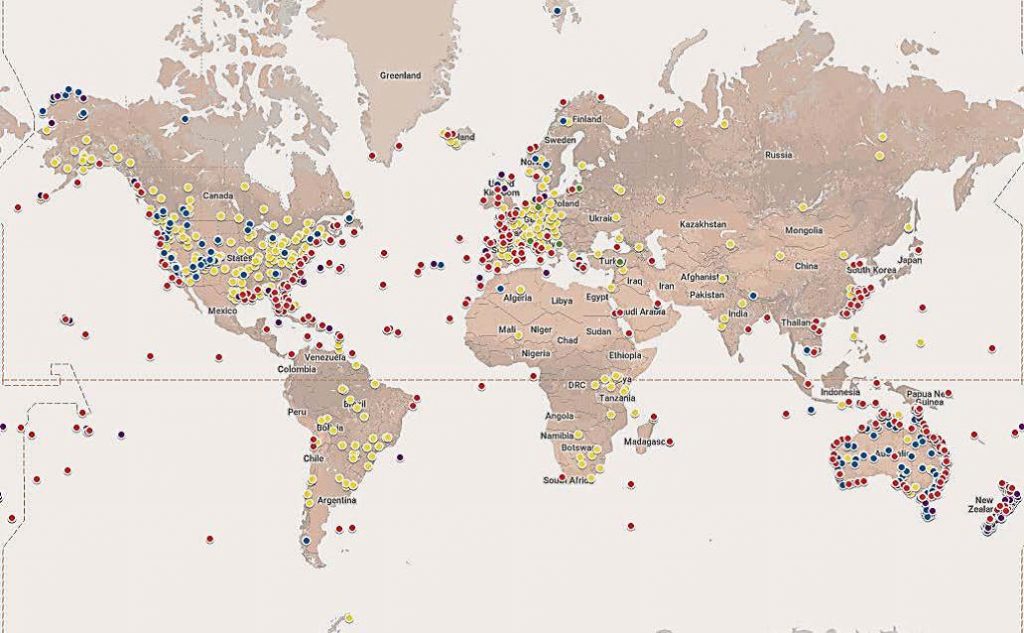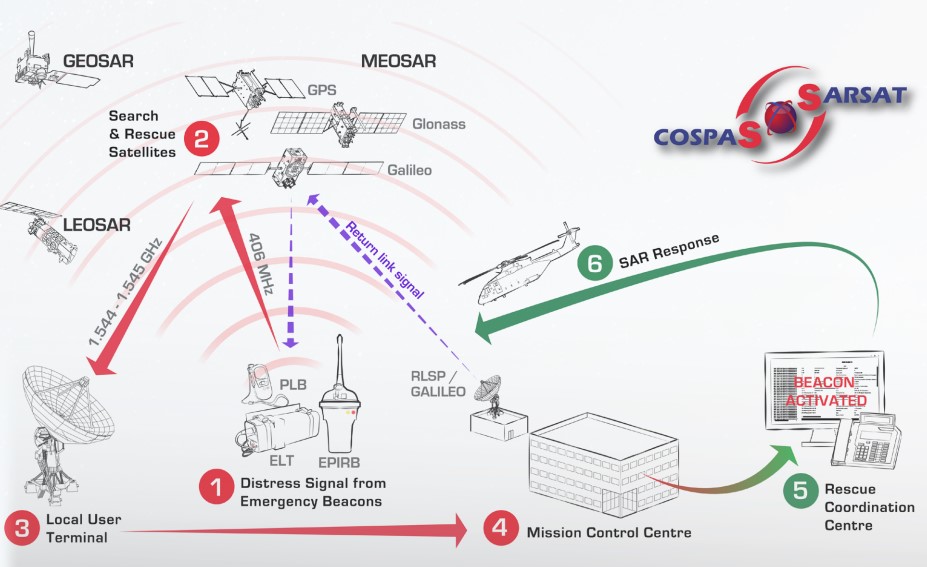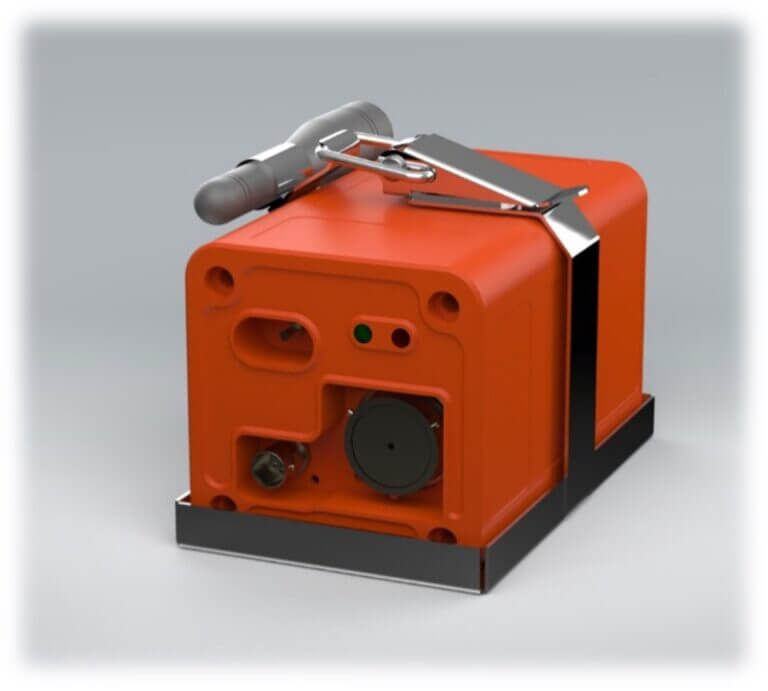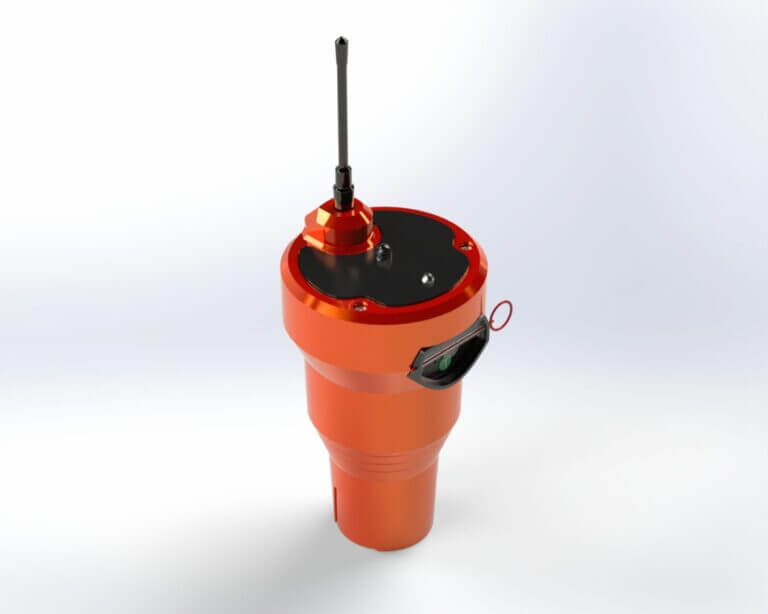COSPAS-SARSAT System
COSPAS-SARSAT is a Search and Rescue (SAR) system that provides danger warning and position information services to users in the air, at sea, and on land using both polar orbit and equatorial orbit satellites.
In 1979, Canada, France, the United States, and the former Soviet Union engaged in the International COSPAS-SARSAT Program to detect distress calls and help emergencies and people in danger. And according to The Washington Post’s issue on 30 September 1982, the first rescue operation was carried out in 1982.

Official Logo of COSPAS-SARSAT Program
Today, 45 countries are part of the COSPAS-SARSAT Program. The full list of participants can be viewed from here. Also, the International Telecommunication Union (ITU), the International Civil Aviation Organization (ICAO), the International Maritime Organization (IMO) all work closely with COSPAS-SARSAT.
What is COSPAS-SARSAT?
In Russian COSPAS stands for “Cosmicheskaya Sistyema Poiska Avariynich Sudov,” which corresponds to “Space System for the Search of Vessels in Distress” while SARSAT refers to “Search and Rescue Satellite-Aided Tracking.”
The purpose of the COSPAS-SARSAT system is to decrease delays in distress alerts to SAR services as much as possible, as well as the time it takes to pinpoint a danger and deliver aid, both of which have a direct effect on the individual in danger’s chances of survival, whether at sea or on land. The COSPAS-SARSAT system is made up of the following components:
- Emergency beacons which transmit the distress signals
- Emergency Locator Transmitter (ELT) for aircrafts
- Emergency Position Indicating Radio Beacon (EPIRB) for sea vessels
- Personal Locator Beacons (PLB) for personal usage
- Satellites that are capable of detecting distress signals transmitted by radio beacons
- Low-altitude Earth orbit (LEO) satellites
- Geostationary Earth orbit (GEO) satellites
- Local Users Terminals (LUTs) as ground receiving stations that receive and process the signals to generate distress alerts
- Mission Control Centers (MCCs) which receive the distress alerts and transfer them to appropriate organizations or other MCCs
How does COSPAS-SARSAT work?
In the case of an emergency such as maritime disaster, plane crash, or missing hiker, distress signals are transmitted from the emergency beacons (ELT, EPIRB, PLB) to the satellites at 406 MHz frequency which is the international search and rescue frequency. These signals, which can be detected by the LEO and GEO satellites scanning the earth’s surface, are transmitted to the Local Users Terminals (LUTs) located at various points on the earth as receiving stations. Location and, if possible, identity information is obtained from the information processed here. The processed information is sent to Mission Control Centers (MCCs) where the search and rescue activities are planned and coordinated. Depending on the information received, such as whether it is an airplane or ship accident or incident location, MCC unit sends the information and a message to the relevant and responsible Rescue Control Center (RCC) or SAR Points of Contact (SPOC). In this way, the intervention to the incident can take place.
It is important to repeat that only distress beacons (ELT, EPIRB, PLB) operating at 406 MHz are received and located by the COSPAS-SARSAT system. Also, distress signals sent on the 121.5 MHz frequency are not supported as of February 1, 2009.
COSPAS-SARSAT in Numbers
As of today, according to the latest issue (No.46) of COSPAS-SARSAT System Data, which is released in December 2020:
- There are about 1.866.000 globally registered beacons as of December 31, 2019.
- Between January and December 2019, the COSPAS-SARSAT system assisted in the rescue of at least 2774 persons in 1032 Search and Rescue (SAR) events as of December 31, 2019.
- 212 of SAR events were aviation distress and 411 persons were rescued.
- 431 of SAR events were maritime distress and 1747 persons were rescued which is the most both in the number of SAR events and persons rescued.
- 389 of SAR events were land distress and 616 persons were rescued.

Geographic Distribution of confirmed SAR events which COSPAS-SARSAT Data Was Used (January – December 2019). Yellow mark shows ELTs, red shows EPIRBs, blue shows PLBs (Land), green shows PLBs (Aviation), purple shows PLBs (Maritime) events.
- Between September 1982 and December 2019, the COSPAS-SARSAT system assisted in the rescue of at least 51.512 persons in 15.563 events
By Can Önal- [email protected]









 Mor Teknoloji
Mor Teknoloji






